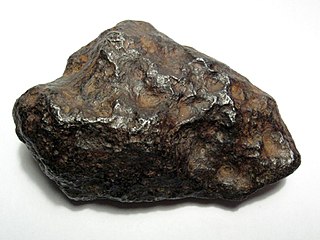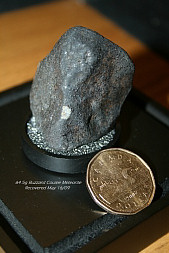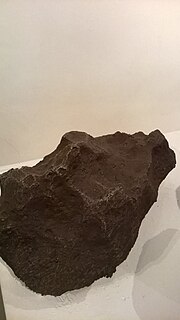
Campo del Cielo refers to a group of iron meteorites and to the area in Argentina where they were found. The site straddles the provinces of Chaco and Santiago del Estero, 1,000 kilometers (620 mi) north-northwest of Buenos Aires, Argentina. It is half that distance, north-east, to Paraguay's capital, Asunción. The crater field covers 3 by 18.5 kilometres and contains at least 26 craters, the largest being 115 by 91 metres.

The Cape York meteorite, also known as the Innaanganeq meteorite, is one of the largest known iron meteorites, classified as a medium octahedrite in chemical group IIIAB. In addition to many small fragments, at least eight large fragments with a total mass of 58 tons have been recovered, the largest weighing 31 tonnes. The meteorite is loosely named after the location where the largest fragment was found: 23 miles (37 km) east of Cape York, in Savissivik, Meteorite Island, Greenland.

Meteoric iron, sometimes meteoritic iron, is a native metal and early-universe protoplanetary-disk remnant found in meteorites and made from the elements iron and nickel mainly in the form of the mineral phases kamacite and taenite. Meteoric iron makes up the bulk of iron meteorites but is also found in other meteorites. Apart from minor amounts of telluric iron, meteoric iron is the only naturally occurring native metal of the element iron on the Earth's surface.

Ataxites are a structural class of iron meteorites with a high nickel content and show no Widmanstätten patterns upon etching.

Iron meteorites, also known as siderites, or ferrous meteorites, are a type of meteorite that consist overwhelmingly of an iron–nickel alloy known as meteoric iron that usually consists of two mineral phases: kamacite and taenite. Most iron meteorites originate from cores of planetesimals, with the exception of the IIE iron meteorite group

The Fukang meteorite is a meteorite that was found in the mountains near Fukang, China in 2000. It is a pallasite—a type of stony–iron meteorite with olivine crystals. It is estimated to be 4.5 billion years old.

Mesosiderites are a class of stony–iron meteorites consisting of about equal parts of metallic nickel-iron and silicate. They are breccias with an irregular texture; silicates and metal occur often in lumps or pebbles as well as in fine-grained intergrowths. The silicate part contains olivine, pyroxenes, and Ca-rich feldspar and is similar in composition to eucrites and diogenites.

Gibeon is a meteorite that fell in prehistoric times in Namibia. It was named after the nearest town: Gibeon.

Brahin is a meteorite pallasite found in 1807. This is the second meteorite ever found in Russia. Sometimes it is also called Bragin or Bragim. It is quite common among collectors due to the affordable price of small partial slices.

Pultusk is an H5 ordinary chondrite meteorite which fell on 30 January 1868 in Poland. The event has been known as the stony meteorite shower with the largest number of pieces yet recorded in history. Made up of rocky debris, it consists of pyroxene or olivine chondrules deployed in mass plagioclase, there being also kamacite.

Buzzard Coulee is the collective name of the meteorites fallen on November 20, 2008 over Saskatchewan, Canada.

The Chinga meteorite is an iron meteorite. It is structurally an ataxite with very rare kamacite lamella. The meteoric iron is a part of the lamella taenite. The total chemical composition is 82.8% iron, 16.6% nickel, and the rest mostly cobalt and phosphorus.

The Dronino meteorite is a 40-kilogram (88 lb) iron meteorite that was found in the Ryazan Oblast of Russia in July 2000. It is classified as an ataxite.

IAB meteorites are a group of iron meteorites according to their overall composition and a group of primitive achondrites because of silicate inclusions that show a strong affinity to winonaites and chondrites.

The Zakłodzie meteorite is a stony-iron meteorite found in Poland in 1998. Its mass is 8.68 kilograms (19.1 lb). It is composed predominantly from enstatite and meteoric iron. Currently classified as an ungrouped enstatite achondrite its classification is still an ongoing scientific debate.
The Bellsbank meteorite is a hexahedrite iron meteorite with abundant schreibersite. It is classified as a member of the IIG group. It was found in Bellsbank, South Africa in 1955.
The Twannberg meteorite is a hexahedrite iron meteorite. It is the only meteorite of the IIG group found in Europe and the largest meteorite ever found in Switzerland.
This is a glossary of terms used in meteoritics, the science of meteorites.

IIAB meteorites are a group of iron meteorites. Their structural classification ranges from hexahedrites to octahedrites. IIABs have the lowest concentration of nickel of all iron meteorite groups. Most iron meteorites are derived from the metallic planetary cores of their respective parent bodies, but in the case of the IIABs the metallic magma separated to form not only this meteorite group but also the IIG group.

Fifteen pieces of the Kainsaz meteorite were seen to fall near Kainsaz, Muslyumovo, Tatarstan on September 13, 1937. The largest weighed 102.5 kilograms (226 lb), the total weight was ~200 kilograms (440 lb). As of January 2013 pieces were on sale for ~US$100/g. Kainsaz is the only observed fall in Tatarstan.


















